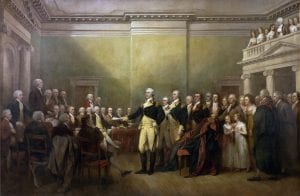Interestingly, the United States (U.S.) Army traces its lineage to the American Army of the 1780s, not the Continental Army that fought the American Revolution.[3] The U.S. Army, however, celebrates its birth on the 14th of June each year. This anniversary documents the birth of the Continental Army on June 14, 1775 when the Continental Congress authorized three different states to raise ten rifle companies, six from Pennsylvania, two from Maryland and two from Virginia to serve near Boston.[4] Congress established the term of enlistment for the initial rifle companies for one year and specified company strength of eighty-one men, a captain, three lieutenants, four sergeants, four corporals, a drummer or trumpeter, and sixty-eight privates.[5] Congress understood when they specifically authorized rifle companies, the nature of the backcountry population and the importance of providing a national vice regional approach to the conflict.
Rifles were standard weapons on the colonial frontier or backcountry, with significant killing power, and the backcountry men who used the rifles were excellent marksmen. Soldiers who could kill the enemy at over 200 yards provided a capability not resident in the New England militia units assembled around Boston. These initial Continental soldiers armed with rifles provided their own clothing and rifles, reflective of their independent backcountry lifestyle. The ability of the riflemen to equip themselves with personal weapons also facilitated the rapid recruitment, organization and deployment of these rifle companies. Even the simple wording of the enlistment contracts signed by these first Continental soldiers reflects the level of commitment expected; the contract even portends an optimistic view that the conflict would end quickly.[6] The enlistment contract prescribed on June 14, 1775, read:
I _____________________ have, this day, voluntarily enlisted myself, as a soldier, in the American continental army, for one year, unless sooner discharged: And I do bind myself to conform, in all instances, to such rules and regulations, as are, or shall be, established for the government of the sad. Army.[7]
The resounding response by the various county committees in Pennsylvania, Maryland, and Virginia resulted in the companies exceeding initial enlistment quotas and men even volunteering to serve without pay. The successful formation of units in Pennsylvania’s western and northern counties resulted in Congress, acting on June 22, authorizing the eight Pennsylvania companies to form a battalion.[8] Congress added a ninth Pennsylvania Company on July 11.[9] The rifle companies formed quickly and began the march north to Boston to join the New England forces operating there, providing the United Colonies a national versus regional army.
Footnotes:
[3] United States Army. About the 3d U.S. Infantry Regiment, http://www.oldguard.mdw.army.mil/regiment, accessed November 15, 2016. [4] Worthington Chauncey Ford, ed., Journals of the Continental Congress, Volume II (Washington: Government Printing Office, 1905), 89-90, http://memory.loc.gov/cgi-bin/query/r?ammem/hlaw:@field(DOCID+@lit(jc00235, accessed November 16, 2016. The Wednesday, June 14, 1775 entry reads in part, “That each company, as soon as compleated, shall march and join the army near Boston, to be there employed as light infantry, under the command of the chief Officer in that army.” June 14 is both Flag Day and the official birthday of the United States Army. Congress authorized the “Stars and Stripes,” on Saturday June 14, 1777. The entry in the Journals of the Continental Congress, 1774-1789, Vol. VIII, 1777, reads “Resolved that the flag of the thirteen United States be Thirteen stripes alternate red and white: that the union be thirteen stars, white in a blue field, representing a new constellation.” See http://www.nationalflagday.com/history.asp accessed November 16, 2016 and http://www.army.mil/birthday accessed November 16, 2016. [5] Ford, Journals, 89; and Arthur S. Lefkowitz, Benedict Arnold’s Army (New York: Savas Beatie, 2008), 291 n62. Morgan’s Company over recruited, departing Winchester with twenty-eight more men than authorized by Congress; Don Higginbotham, Daniel Morgan Revolutionary Rifleman (Chapel Hill: University of North Carolina Press, 1961), 23; Upon arrival in Lancaster, Pennsylvania in route to Boston, Cresap’s Maryland Company contained 130 men; J. B. Wisker, The American Colonial Militia: The Pennsylvania Colonial Militia (Vol. 3) (Lewiston, NY: The Edwin Mellon Press, 1997), 100. Smith’s Company had at least one volunteer citizen, Mr. Simpson; most companies apparently exceeded their recruiting quotas and added volunteers to the rosters who served without pay. [6] Thomas Lynch Montgomery, ed., Pennsylvania Archives, Fifth Series, Volume II (Harrisburg: Harrisburg Publishing Company, State Printer, 1906), 4; Lefkowitz, Benedict Arnold, 44-46. [7] Ford, Journals, 90. [8] Ibid., 104; Wright, Continental Army, 5. The term regiment and battalion were largely synonymous in the British and new American military structure; most other nations included two battalions in a regiment the British and Americans did not. The Continental Army eventually adopted the regiment as the standard headquarters for controlling groups of companies but the term battalion was used through the American Revolution. [9] Ford, Journals, 173; Wright, Continental Army, 25-26. The ninth company was the second company raised in Lancaster County.


